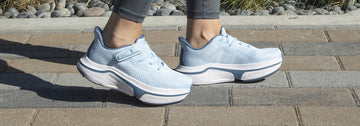Some cases of foot drop are permanent, but many can heal with time and appropriate care. Wondering whether your foot drop is getting better? In this guide, we help you identify the signs of healing from foot drop. These signs let you know that what you are doing is helping, and your recovery is on track.
First of all, what is foot drop? According to Mayo Clinic, foot drop is a condition where you are unable to lift the front part of your foot. As a result, you may have an unnatural, dragging gait as you walk.
Foot drop has a variety of causes. Some possible causes include stroke, multiple sclerosis, traumatic brain injury (TBI), peroneal nerve damage, amyotrophic lateral sclerosis (ALS), muscular dystrophy, and even things like sitting, kneeling, or squatting in particular positions for too long.
Penn Medicine states that injury to the peroneal nerve is the most common cause for foot drop. This nerve can be damaged through a knee injury, time spent in a coma, wearing a cast on the lower leg that is too tight, or even just wearing high boots frequently.
A type of peripheral neuropathy called Charcot-Marie Tooth disease (CMT) also can lead to foot drop. If you have neuropathy affecting your feet, you may find these natural treatments helpful, as well as what you should know about walking with neuropathy. If neuropathy is severe, be sure to see your doctor right away.
Either or both feet may be affected by foot drop. If you experience foot drop, raising your feet is difficult when walking or climbing, and when you put your feet down, they can slap the ground. You might develop a tendency to take high, unnatural steps to try and keep your toes from dragging.
You may also notice weakened muscles, and you may even have a reduction in muscle mass. Your foot or leg might exhibit nerve symptoms, such as tingling or numbness. It could also become harder to maintain your balance.
There are many situations where foot drop can improve, or it may even go away entirely. Studies show that 88% of foot drop cases resolve with proper treatment. If that is the case for you, you may start to detect signs of healing foot drop. Let’s go over those now.
When you cannot lift the fronts of your feet and you must adopt an unnatural gait to walk with foot drop, that can affect your balance.
The natural way to walk is with the heel striking the ground before the toes do. But foot drop causes the toes to touch down before the heel does. This is what leads to people with foot drop tripping.
So, if you notice your balance beginning to improve, that might point toward improvements in your ability to lift your feet and walk normally.
Along with your balance, foot drop can have an adverse effect on your coordination. When you are unable to raise and lower your feet naturally, it is hard to achieve a normal walking cadence. You might also have difficulty clearing obstacles or moving your feet across the distance and height that you had intended.
If your coordination is beginning to improve, that is a good sign that your foot drop may also be reducing.
Sometimes it is difficult to get a gauge on the changes in your physical health, especially over a long, slow healing process. Even if you take careful notes, your observations may be somewhat subjective. You might struggle to assess your progress based on balance, coordination, and physical symptoms alone to determine whether your foot drop is decreasing from day to day or remaining the same.
In situations like that, it may work better to instead take a look at how you are living your overall life for signs of improvement.
For example, let’s say foot drop was severe enough that it was preventing you from exercising, and you were also dreading going on errands.
But over the past few weeks, you have been running your errands without worrying, and you have even been able to exercise. These are both indications your condition may be improving.
Of course, it could just be, in some cases, that you are adapting to living with the condition. Whether or not that is the case probably depends both on the adaptations you make and your psychology.
However, if you notice a reduction in the stress and effort involved in living independently and doing activities that involve walking and climbing, there is a good chance it points toward real recovery. Adapting makes you resilient, but it doesn’t make living with a condition like foot drop easy.
The healing time from foot drop varies based on the underlying cause, your lifestyle and habits, treatments, and other factors.
As one example, patients who received surgery for degenerative lumbar diseases saw foot drop improvements within 6 weeks.
On the other hand, recovery took about 3 months in cases of foot drop involving peripheral compressive neuropathy.
Ask your doctor how long they expect foot drop recovery to take given your condition and the steps you are taking to treat it.
Also, please keep in mind that while many patients do recover from foot drop, in some, it is a chronic or permanent condition.
It might surprise you to learn that one thing that can potentially speed up your recovery time from foot drop is your choice of shoes.
Typical shoes are designed with the assumption that you are able to lift your toes and walk with a natural gait. As a result, they do nothing to help you move correctly when you are unable to lift the fronts of your feet.
To address this gap in footwear, Cadense has developed a collection of shoes for foot drop, including the Cadense Original Adaptive Shoe for men and women.
The Cadense Original Adaptive Shoe features an innovation called patented variable friction technology. With this technology, it is possible to “glide” over uneven surfaces and obstacles, even when it is not possible for you to lift your toes correctly because of foot drop.
These adaptive shoes also fit snugly and comfortably, providing support and comfort as you walk, and also increasing stability. In addition, they are stylish and easy to put on and take off. You can choose from a number of different colors, including white, black, gray, blue, and pink.
When you walk in the Cadense Original Adaptive Shoes, you should find it easier to maintain your balance and coordination. As a result, you will stay safer, as the chances of slips, trips and falls reduces. You will also not be tempted to develop an unnatural gait with a high step.
Just being able to walk more comfortably and safely with foot drop will encourage you to get more exercise. This, in turn, will help you to enhance flexibility, strength and circulation in your legs, feet and ankles, and promote overall health. Over the weeks or months ahead, this may bolster your healing process.








![[color: black] Original Men's Adaptive Shoe](http://cadense.com/cdn/shop/files/Mens-BLK-T1-LG.jpg?crop=center&height=300&v=1765338442&width=300)
![[color: white] Original Women's Adaptive Shoe](http://cadense.com/cdn/shop/files/Womens-WHT-T1-LG.jpg?crop=center&height=300&v=1765381322&width=300)





